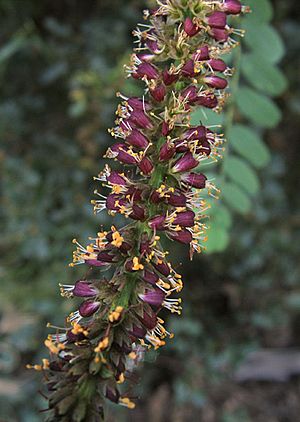California false indigo facts for kids
Quick facts for kids Amorpha californica |
|
|---|---|
 |
|
| var. californica | |
| Conservation status | |
| Scientific classification | |
| Kingdom: | |
| (unranked): | |
| (unranked): | |
| (unranked): | |
| Order: | |
| Family: | |
| Subfamily: | |
| Genus: |
Amorpha
|
| Species: |
A. californica
|
| Binomial name | |
| Amorpha californica Nutt.
|
|
Amorpha californica is a type of flowering plant in the pea family. It's often called the California false indigo. This plant grows naturally in California, Arizona, and northern Baja California (which is in Mexico). You can find it in places like chaparral and oak woodlands.
What Does California False Indigo Look Like?
The California false indigo is a shrub that doesn't have thorns. It has special glands that make it feel a bit sticky. Its leaves are made up of many small, oval-shaped parts called leaflets. Each leaflet has a tiny spine and a gland that produces a sticky substance.
When the plant flowers, it grows long, spike-like clusters of blooms. These clusters are called racemes. Each flower has only one violet-colored petal. From the center of the flower, ten long parts called stamens stick out. After the flowers, the plant produces a fruit that looks like a small pod. This pod usually holds just one seed.
Butterflies That Love This Plant
The California false indigo is very important to a special butterfly called the California dogface butterfly. This butterfly is endemic to California, which means it's found only there and nowhere else in the world. The young butterflies, called larvae or caterpillars, eat the leaves of the Amorpha californica plant. This plant is their main food source!
See also
 In Spanish: Amorpha californica para niños
In Spanish: Amorpha californica para niños


